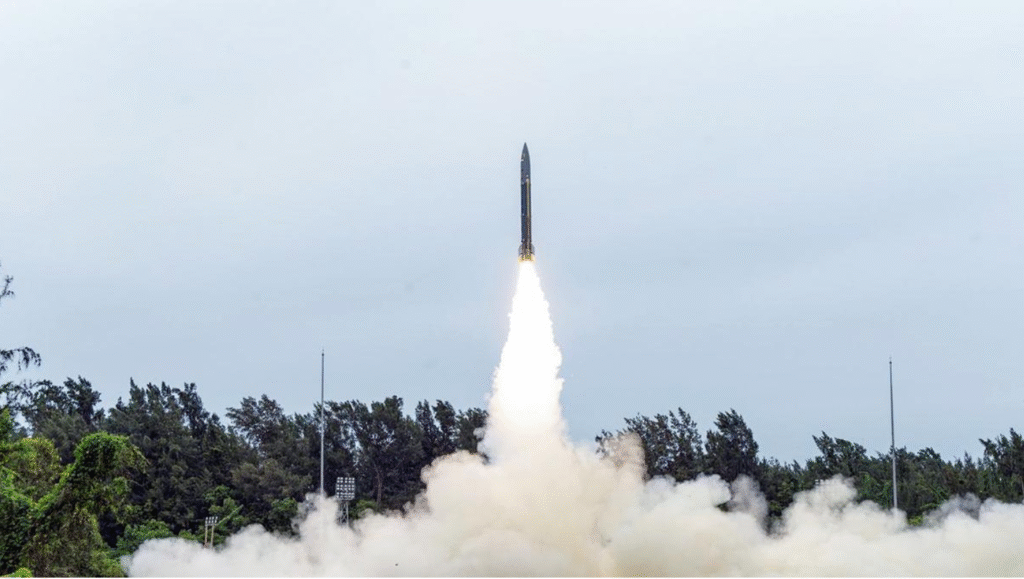DRDO’s Pralay Missile: A Boost to India’s Tactical Missile Capabilities
Syllabus: Internal Security, Science & Technology (UPSC GS III)
Source: The Hindu
Context:
In July 2025, the Defence Research and Development Organisation (DRDO) successfully conducted two consecutive flight tests of the indigenously developed Pralay missile from Dr. APJ Abdul Kalam Island, Odisha. These tests validate the system’s operational readiness and reflect India’s growing conventional deterrence capabilities.
What is the Pralay Missile?
Pralay is a short-range, surface-to-surface tactical ballistic missile developed by DRDO for conventional strike roles. It is India’s first quasi-ballistic missile system designed for rapid deployment in battlefield conditions without crossing the nuclear threshold.
- Initiated: 2015
- Nodal Agency: Research Centre Imarat (RCI), DRDO
- Project Cost: ₹332.88 crore
- First Public Display: Republic Day Parade 2025
- Induction Plan: Over 370 units cleared for induction by Indian Army and Air Force, particularly for deployment along the LAC and LoC.
Key Technical Parameters
| Feature | Description |
|---|---|
| Range | 150–500 km (scalable) |
| Payload Capacity | 350–1,000 kg (conventional warheads) |
| Accuracy | CEP less than 10 meters |
| Speed (Terminal Phase) | Up to Mach 6.1 |
| Propulsion | Two-stage solid-fuel with MaRV (maneuverable re-entry vehicle) |
| Mobility | Road-mobile; mounted on 8×8 BEML Tatra launcher |
| Guidance System | Inertial navigation with mid-course correction |
Strategic Utility and Operational Role
- Conventional Deterrence:
Serves as a tactical deterrent capable of striking high-value enemy targets—such as airfields, missile launchers, radar posts, and logistics hubs—deep inside hostile territory. - Force Multiplication:
Complements existing systems like BrahMos (cruise missile) and Agni (strategic missile) to establish a layered strike capability. - Rapid Response:
Road mobility and quick launch capability allow rapid retaliation and operational flexibility, crucial in high-tempo, short-duration conflicts. - Indigenous Capability:
Demonstrates DRDO’s growing self-reliance in high-precision missile systems, aligned with the Aatmanirbhar Bharat vision in defence.
Why It Matters: Geopolitical and Strategic Relevance
- Bridging Capability Gaps:
Fills a long-standing void in India’s conventional missile arsenal by introducing a non-nuclear, short-range system akin to China’s Dong Feng-12 and Pakistan’s Nasr. - Enhanced Battlefield Readiness:
Pralay ensures credible deterrence and offensive capability in border zones where escalation risks are high and swift retaliation is essential. - Deterrence Without Escalation:
Offers precision-targeting options without resorting to nuclear weapons, making it a suitable tool in India’s escalation control doctrine. - Modern Warfare Compatibility:
Designed for future battlefield environments—featuring mobility, survivability, speed, and deep-strike potential, especially in anti-access/area denial (A2/AD) scenarios.
Conclusion
The successful development and testing of Pralay reflect India’s advancing defence technological ecosystem and strategic foresight in modern warfare. As a potent tactical missile, it enhances India’s deterrence posture, improves military readiness along sensitive borders, and marks a significant stride towards indigenisation in the defence sector.











